How to Set Up Solitaire: Easy Instructions with Examples

Solitaire, also known as Klondike Solitaire, is a popular single-player card game with several variations. This post shows you the step-by-step process for setting up Classic Solitaire while introducing basic Solitaire terms, moves, and variations to get you ready to play. To start playing the Solitaire card game, you just need a standard deck of cards (or the online version) and yourself!
Fast Setup Instructions for Solitaire
Setting up Solitaire doesn’t have to be complicated. Here’s the entire process distilled into a few quick steps:
- Shuffle the full deck (using all 52 cards).
-
Build the tableau (the main play area with seven columns). Deal the cards one at a time from left to right across the columns, starting with a face-up card in the first column and facedown cards for the rest. Each time you start a new row, move one column to the right. Begin with a face-up card in the initial column and facedown cards in the rest of the columns. Repeat this pattern until all seven columns are dealt. When finished, you should have:
- Column One → One card face up
- Column Two → One card facedown + one card face up
- Column Three → Two cards facedown + one card face up
- Column Four → Three cards facedown + one card face up
- Column Five → Four cards facedown + one card face up
- Column Six → Five cards facedown + one card face up
- Column Seven → Six cards facedown + one card face up
- Remember: Only the top card in each column should be face up; all others remain facedown.
- Leave four empty spaces above the tableau for the foundations, which are the piles where you’ll eventually build each suit from ace through king.
- Place the stockpile facedown in the upper left corner above the tableau. This is the stack of leftover cards.
- Start the waste pile (also known as the talon pile) to the right of the stockpile. Whenever you draw from the stockpile, flip the card face up and place it here.
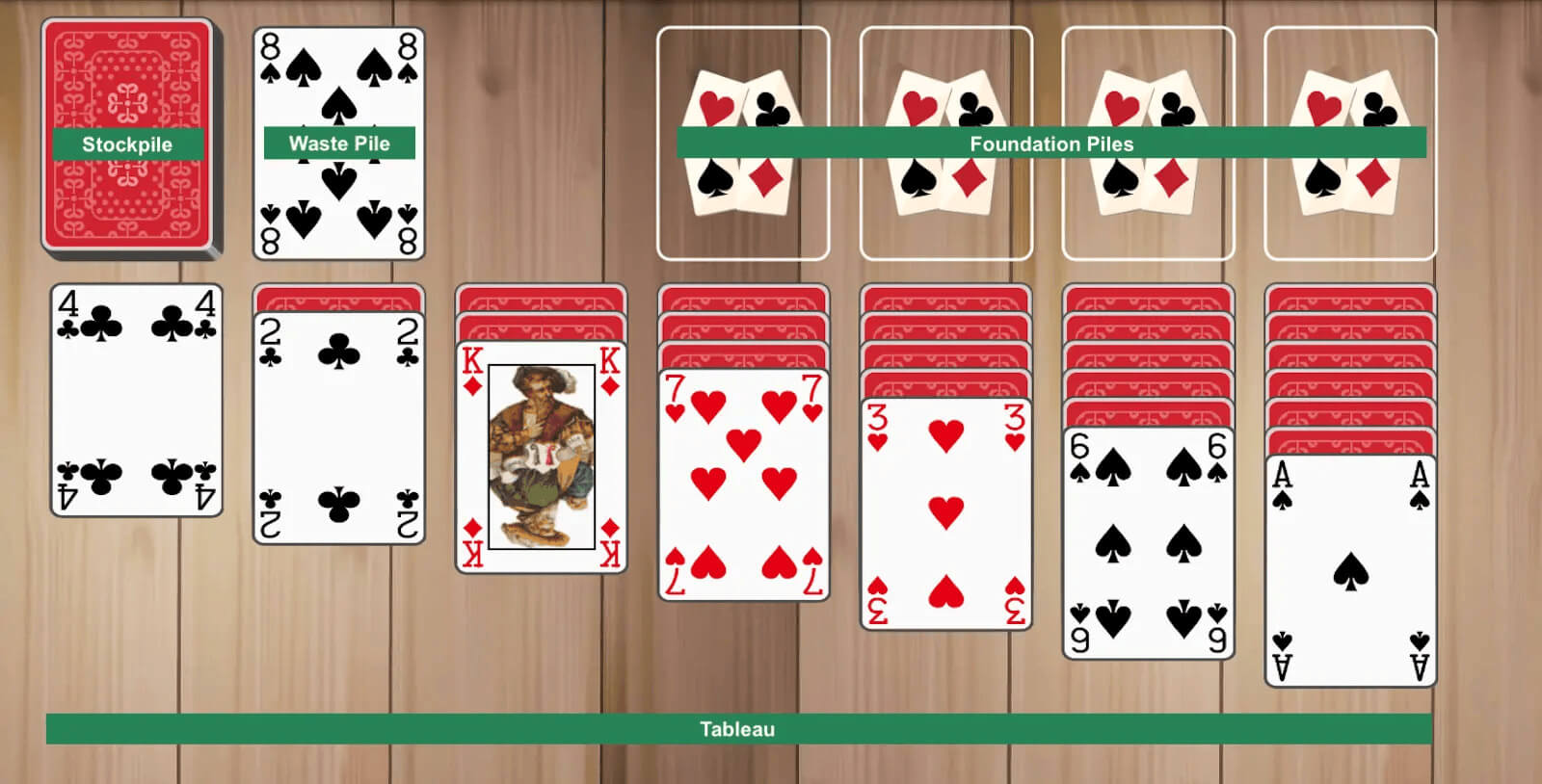
That’s the full setup: tableau across the bottom, stockpile in the top left, waste pile just to its right, and four empty foundation spaces across the top. For a deeper breakdown of each step (with examples and visuals) keep reading below.
Setting Up Solitaire: Step-by-Step Instructions for Beginners
Now that you’ve seen the quick version, it’s time to break down the setup, card by card. These step-by-step instructions show exactly how to deal the tableau, where to place the stockpile and waste pile, and how to leave space for your four foundations. Follow this sequence once, and you’ll never second-guess your Solitaire setup again.
Step 1: Deal Seven Cards in a Row with the First Facing Up
After shuffling a deck of 52 cards, begin a Solitaire round by creating the initial tableau: Deal seven cards in a row from left to right with the first card face up and the others facedown. You should then have a row of seven cards across, with only the card on the far left facing up. These seven cards form the basis of your columns.
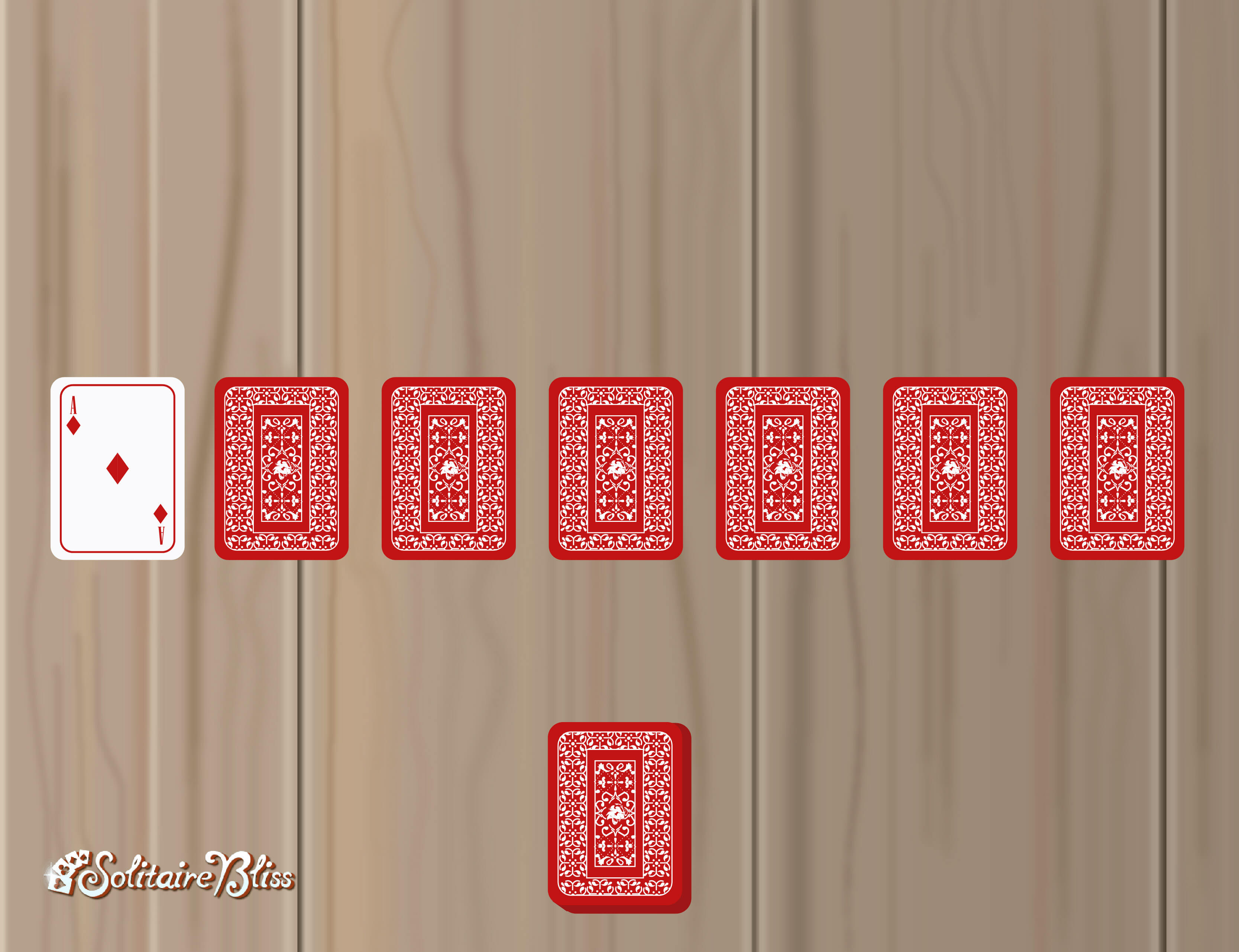
Step 2: Starting on the Second Column, Deal Six Cards with the First Facing Up
Repeat the pattern above, starting with the second card from the left. Deal one card face up on the second column and one card facedown on each of the remaining five columns.
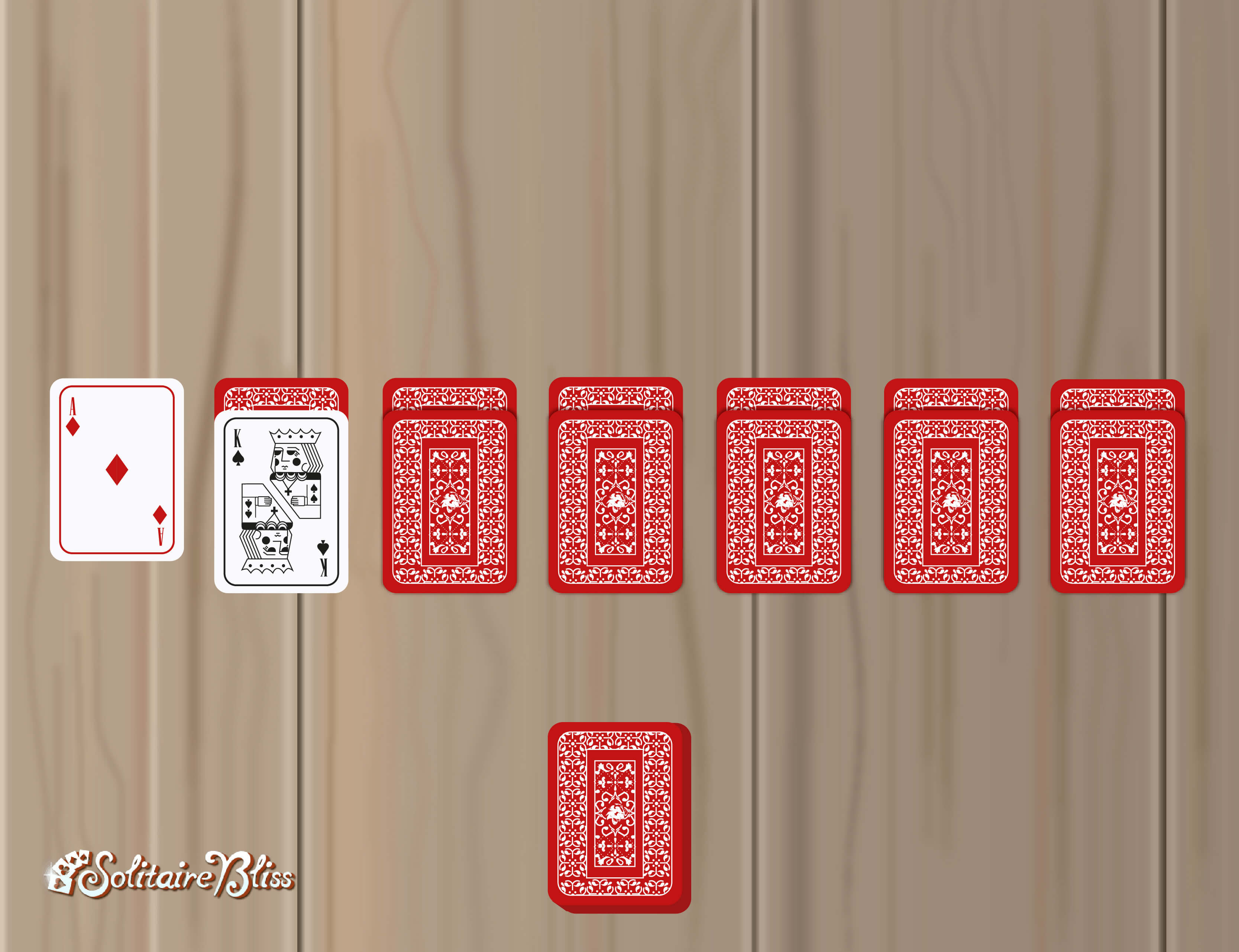
Step 3: Continue the Dealing Pattern
After the first two columns are set, keep following the same pattern: Place one face-up card on the next column in line, and then deal facedown cards on every column to its right.
For example:
- On the third pass, place a face-up card on Column Three, then facedown cards on Columns Four through Seven.
- On the fourth pass, place a face-up card on Column Four, then facedown cards on Columns Five through Seven.
- Continue until Column Seven ends with a single face-up card on top of six facedown cards.
When this sequence is finished, each of the seven columns will be staggered, with only the top card face up.
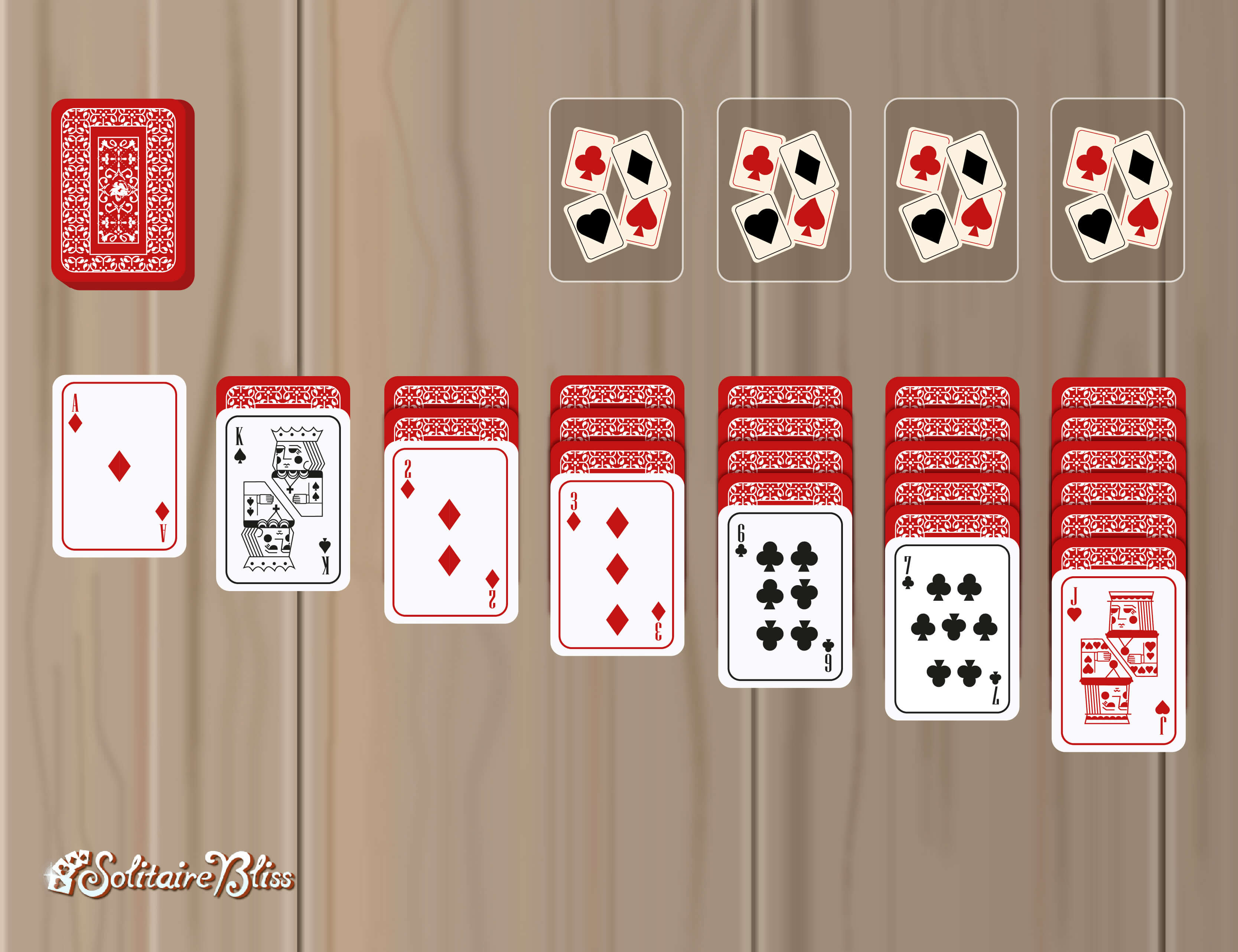
Step 4: Place the Stockpile Above the Tableau
The 24 cards that remain after you set up your tableau constitute your stockpile. Place the stockpile in a stack above the tableau on the left-hand side. During the course of the game, you will draw cards from this stockpile and place them face up into the waste pile, which sits to the right of the stockpile. You can attempt to play these face-up cards from the waste pile into your Solitaire tableau or onto foundation piles. When you can no longer play a card from the waste pile, you can draw again from the stockpile.

Step 5: Create a Space for Your Foundation Piles
Create a space—generally above the tableau and to the right in Classic Solitaire—for your foundation piles. You need room for four piles of cards, one for each suit. Eventually, you will have two red piles (hearts and diamonds) and two black piles (clubs and spades).
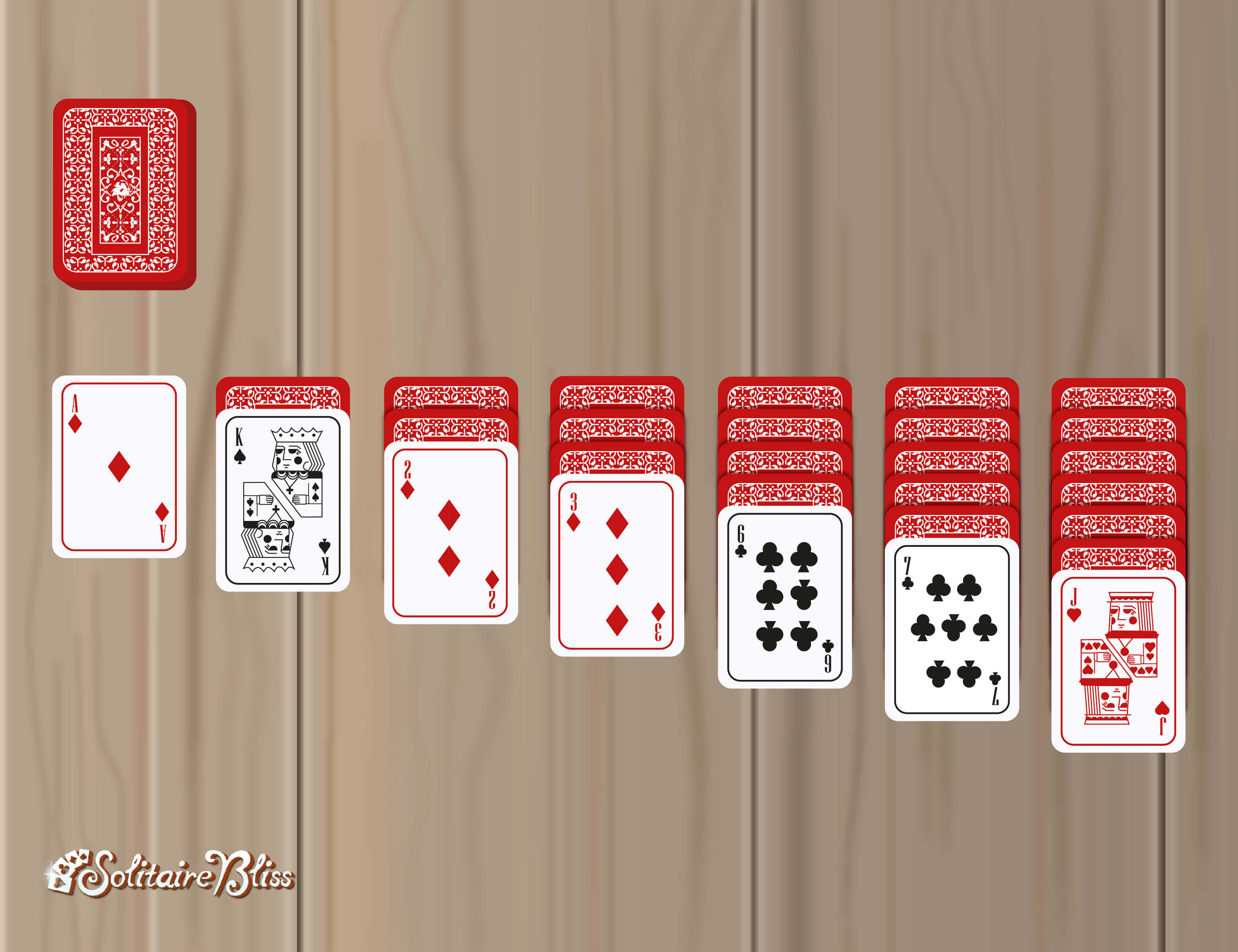
Step 6: Begin Playing
As soon as you’ve set up your tableau, you can start moving your playing cards.
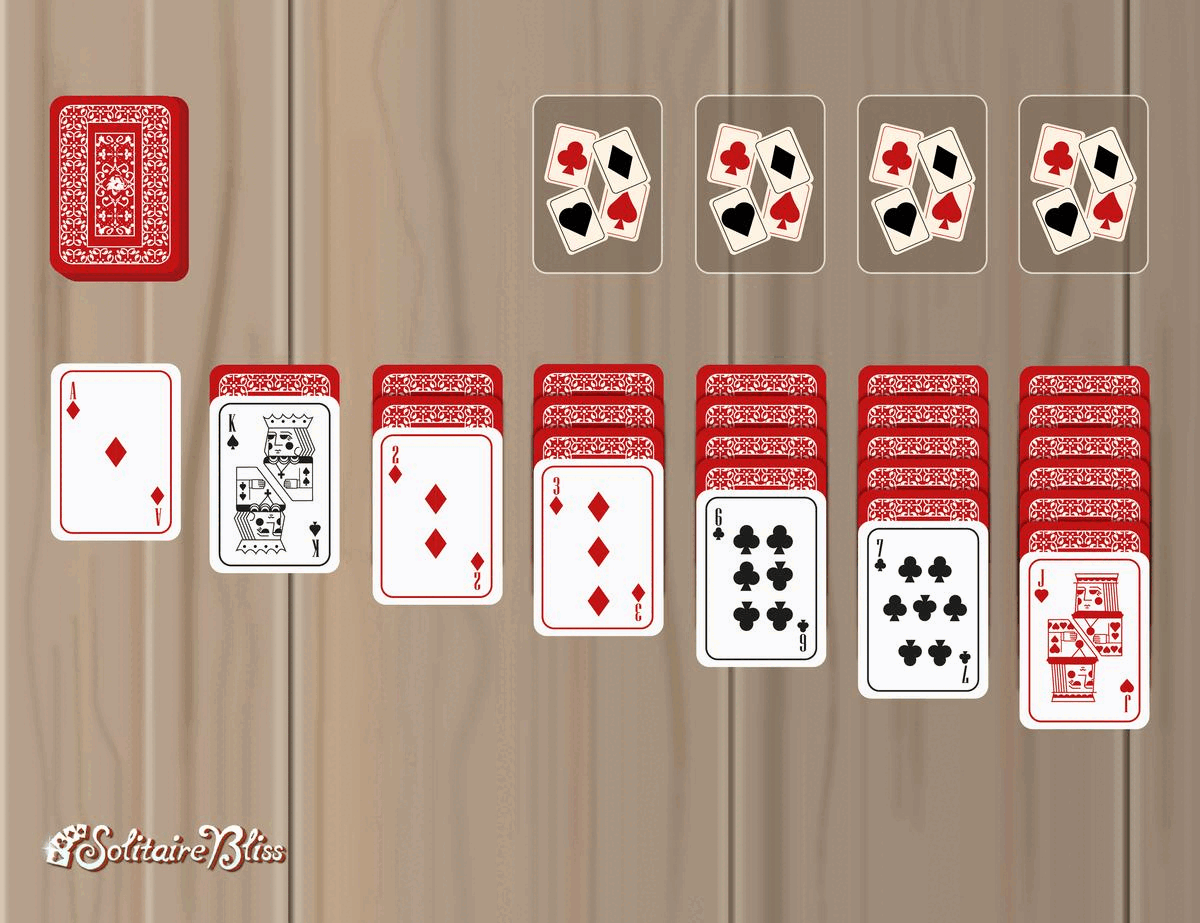
How to Play Solitaire: Rules and Strategies
With your setup complete, the real fun begins. Solitaire is easy to pick up but surprisingly strategic once you know the moves. To dive deeper into tactics that can improve your odds, follow these Solitaire rules and strategies.
1. Build Your Foundations from Ace to King by Suit
Foundation piles must begin with aces. So if you see an ace of any suit face up in your tableau, move it to begin a foundation pile. Then you build each pile in ascending order by suit, from ace to king.
Example: If the ace of hearts is already in its foundation, you can place the two of hearts on top, then the three of hearts, and so on.
You win the game by completing all the foundation piles, which clears all the cards from the tableau and stockpile.
Strategy tip: Avoid building your foundation piles unevenly. You only have two possible cards to place on a column where you’re building sequences. For example, you only have the five of hearts and five of diamonds to play on a black six. So if you build your hearts or diamonds foundations too high, you may bury the five you need to build a sequence on the six.
2. Rearrange Tableau Cards in Descending Order, Alternating Color
Face-up column cards should be arranged in descending order by opposite color so that the colors alternate through the column. You can also move ordered stacks of face-up cards as long as they follow the sequencing rule.
Example: Place an eight of diamonds (red) on a nine of spades (black). Then place a seven of clubs (black) on top of the eight of diamonds. Or if moving a sequence, move the nine of spades, eight of diamonds, and seven of clubs as a group and place it on top of a ten of hearts.
Creating sequences helps you to arrange cards in order and reveal more facedown cards, all of which help you build your foundation piles.
Strategy tip: Focus on creating longer runs in the tableau before moving every possible card to the foundation piles. These long sequences help you pull more cards into play. Locking cards away too soon can cut off moves you’ll need later.
3. Only Face-Up Cards Are Playable
Whether in the waste pile or tableau, you can only play cards that are face up. And each time you move a card (or a stack) away, the card underneath it becomes playable.
Example: You move the eight of clubs off a column onto a red nine in another column, so the facedown card underneath can be flipped over and put into play.
Revealing facedown cards is essential because it opens new options, helps you extend sequences, and often unlocks moves you couldn’t make before.
Strategy tip: Prioritize moves in columns with a lot of hidden cards. So if two red eights are available to play on a black nine, play the eight that’s sitting on the column with the most facedown cards. Then you open up the most possibilities.
4. Use Empty Tableau Columns for Kings
As you move cards around your tableau, you may end up with an empty column. When that happens, you can start a new column but only when you have a king. You can move face-up kings (or sequences that begin with a king) from your tableau to the empty space or start a new column with a king from the waste pile.
Example: If column four becomes empty, you can place a king there, or move a sequence beginning with a king (such as king of spades, queen of hearts, and jack of spades) to that spot.
Empty columns placed with kings give you a dedicated space to build long sequences that can help you get cards in order and more cards into play.
Strategy tip: Try to open a space only when you already have a king ready to move into it; otherwise, you empty a column and reduce the amount of space in which you can sequence cards.
5. Draw from the Stockpile When Stuck
When no more moves are possible in the tableau, draw from the stockpile (the facedown stack in the upper left). Each card you draw is placed face up into the waste pile, and only the top card of the waste pile is playable. You can move that card into the tableau or onto a foundation pile if it fits. When your stockpile runs out, simply turn over your waste pile and make it the new stockpile, but you cannot shuffle the waste pile.
Example: Different versions of Solitaire change how many cards you draw at once.
- Turn 1 (one-card draw): Turn over one card at a time. If it can be played, move it to a tableau pile or foundation.
- Turn 3 (three-card draw): Flip over three cards at once, but only the top card (the third one) is playable at first. If you’re able to play it, the card beneath it becomes available, and so on. This variation is more difficult because you can’t reach every card right away.
The face-up card on your waste pile can always be played at any time like any other face-up card, so don’t forget to check your waste pile while playing because it can help you unlock the tableau when you get stuck.
Strategy tip: Keep track of the cards in the stockpile. Even though you may not be able to use them immediately, you might need them when you next cycle through it.
6. Win by Finishing the Foundations
A winning game of Solitaire occurs when you move all the cards in the deck to their correct foundation pile by suit in ascending order. In other words, when you have one pile of hearts, one of clubs, one of spades, and one of diamonds—all stacked in order with an ace on the bottom and a king on the top—you win!
Setup for Popular Solitaire Versions
The possible versions of this famous single-player game are limited only by the imagination—by some estimations, over 500 Solitaire variations already exist. We’ve listed the most popular Solitaire games below, along with how the card layouts may differ from Classic Solitaire:
- Spider: Spider Solitaire uses two decks of cards dealt into 10 columns in the tableau. Six cards each go into the first four columns and five cards each go into the other six columns, for a total of 54 cards in the initial tableau. The 50 cards that remain go into the stockpile. You move cards to make columns in descending order from king to ace.
- FreeCell: Like Classic Solitaire, FreeCell Solitaire uses one standard 52-card deck. Unlike Classic Solitaire, however, the main tableau has eight columns and four “free cells" above it where cards can be temporarily stored. The goal is to move all the cards to the foundations by building down in alternating colors in the tableau and moving cards to the foundations in ascending order.
- Yukon: Yukon Solitaire is a variation of Klondike that removes the stockpile entirely. All 52 cards are dealt into seven tableau columns, and you can move groups of cards regardless of order, as long as the bottom card being moved fits the destination column’s rules (one rank lower, opposite color).
- Forty Thieves: Forty Thieves Solitaire uses two decks of cards and 10 tableau columns of four cards each. The goal is to build the foundations in suit from ace to king. You can only move one card at a time, and tableau columns are built down in suit.
- Golf: Golf Solitaire uses one deck of cards arranged in seven tableau columns of five cards each. The objective is to clear the tableau by moving cards to a single foundation pile one rank higher or lower than the top card of the foundation.
- Pyramid: Pyramid Solitaire is played by dealing cards in the shape of a pyramid, with one card in the first row, two in the second, and so on up to seven rows. The goal is to remove pairs of exposed cards that add up to 13. Kings are worth 13 and can be removed individually, queens are worth 12, jacks are worth 11, and aces are worth 1.
Ready to Play?
Now that you know the layout and some of the basic moves for Classic Solitaire, you’re ready to get started. As you become familiar with the many different ways to play Solitaire, you can try different versions and pick the one you like to play the best.
Back to the Homepage

